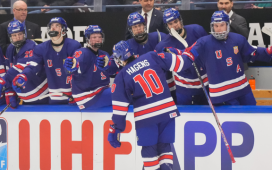There was no way the Vegas Golden Knights could have known how poorly the Tomas Tatar acquisition at the 2018 trade deadline was going to work out. But, boy, is it a deal that went south.
In the franchise’s first deadline splash, the Golden Knights shipped a first-round, second-round and third-round selection to the Detroit Red Wings in exchange for Tatar and had every expectation that the then-three-time 20-goal scorer would slot into the top six, rounding out an already-effective attack. Instead, Tatar flopped. In 20 games to close out the season in Vegas, he managed four goals and six points while steadily falling out of favor with the coaching staff. And the post-season only shone a light on how poor a fit he was with the Golden Knights.
Three games into the opening-round series against the Los Angeles Kings, which followed two Vegas victories that kicked off what would turn out to be a run to the Stanley Cup final, Tatar found himself watching from the press box. He remained there until Games 3 and 4 of the second round, but was again made a scratch until Games 2 and 3 of the Western Conference final. By Game 4 of the third round, Tatar again wound up a scratch, and he didn’t see the ice again until Games 4 and 5 of the Stanley Cup final, the latter the contest in which the Washington Capitals downed Vegas to take home the hardware.
Of course, Tatar has since revived his career with the Montreal Canadiens and finds himself one of the top trade targets as the deadline approaches. And while some teams may proceed with caution given his past post-deadline performance in Vegas, it seems unlikely he’ll suffer the same surprising downturn should he end up elsewhere by Monday.
However, there are several players who could turn into post-deadline duds in much the same way Tatar did two seasons ago.
Conor Sheary, RW, Buffalo Sabres
Teams tend to covet players who have experience in the post-season, and what better experience is there than winning the Stanley Cup not once, but twice? For that reason alone, Sheary will be a trade target. But any team acquiring the 27-year-old needs to first remind themselves that they’re not getting the same player whose offense was buoyed by playing alongside Sidney Crosby. Since his breakout 53-point sophomore season, Sheary has posted 30-point and 34-point campaigns and is on pace for a 27-point output this season. His offense is evaporating, which is due in part to his inability to find a comfortable fit anywhere but the third and fourth lines in Buffalo.
Maybe Sheary is acquired for nothing more than a seventh-round pick with a minor condition, but the risk is that a team pays more for him up believing they can tap into that old upside. However, unless that team is the Penguins and Sheary is reunited with Crosby, it seems far more likely the current Sabres winger fails to meet expectations.
Erik Gustafsson, D, Chicago Blackhawks
There may be no rental player with greater boom or bust potential than Gustafsson, and any team taking a shot on the 27-year-old rearguard will need to be aware of that. Offensively, this campaign has been a massive letdown for Gustafsson, who is on pace to score eight goals and 35 points after a 17-goal, 60-point output last season. Those are still respectable offensive totals, though, and he’s surely capable of playing on any team’s second power play unit if some extra oomph on special teams is what a club is after.
Where teams need to be cautious, though, is expecting Gustafsson to come aboard and skate reliable top-four minutes. He’s logged plenty of ice time in Chicago, to be sure, and is up above 20 minutes per game for the second season running, but he’s prone to defensive lapses. Of the four Blackhawks defenseman to play at least 500 minutes this season, Gustafsson has the worst expected goals against rate at five-a-side.
Jimmy Howard, G, Detroit Red Wings
Here’s the situation as it pertains to the blue paint heading into the deadline. There are several goaltenders who could be pried out of their current locales, notably keepers such as Blackhawks duo Robin Lehner and Corey Crawford. The price for a goaltender with starting potential is going to be awfully high, however, and clubs with an eye on strengthening their crease may instead seek cheaper options. Howard is one of those options, a 35-year-old on an expiring deal with a manageable $4-million cap hit that can be lowered if the Red Wings retain some salary.
But Howard is a risky choice for a split-time starter down the stretch or a reliable No. 2 netminder for a few reasons. He’s had a dreadful year for an admittedly awful Detroit club, he’s in the twilight of his career as it is and his injury history is a red flag. He’s missed at least some time in each of the past four seasons, including 10 games with a groin injury this season. Spending to acquire him only to lose him would be the worst-case scenario.
Ilya Kovalchuk, RW, Montreal Canadiens
Before everyone gets all up in arms, this comes with a couple caveats.
First, there’s a matter of the price to pry Kovalchuk out of Montreal. At one time, if the 36-year-old was going to be flipped at the deadline, it appeared the cost for an acquiring team might be a late-round draft choice and maybe another conditional selection. And that was at most. Kovalchuk’s performance with the Canadiens has surely driven up his price, though. He has six goals and 12 points and only seven pending UFA forwards have a higher per-game points output.
More importantly, though, might be where an acquiring club slots Kovalchuk. We’ve already seen him disappear for stretches in Los Angeles as a bottom-sixer and Kovalchuk is at his best when he’s getting regular minutes. If would be senseless for any team to pay up for Kovalchuk and slot him into the bottom half of the lineup. So, if that’s the only place he appears as though he’ll fit, buyer beware.
Wayne Simmonds, RW, New Jersey Devils
There was a time when Simmonds’ name would have never wound up on such a list. From 2013-14 to 2016-17, he posted four consecutive seasons of 28 or more goals, registered at least 50 points in each of those campaigns and was a legitimate top-six power forward. But then came the decline, and it has been steep. He notched 24 goals in 2017-18, slipped to 17 in 2018-19 and has seven in 60 games this season. Of course, that won’t stop teams from being attracted to the 31-year-old at the deadline. He’s a pure rental, can play in the bottom six and chip in on the second power play unit.
The concern, though, is that whatever team acquires him is in for a repeat of last season. He scored one goal and three points in 17 regular season games with the Nashville Predators before falling injured in the post-season. Simmonds’ best days are behind him, and there’s not much to gain by getting into a deadline bidding war for his services.
Want more in-depth features and analysis? Subscribe to The Hockey News magazine.








